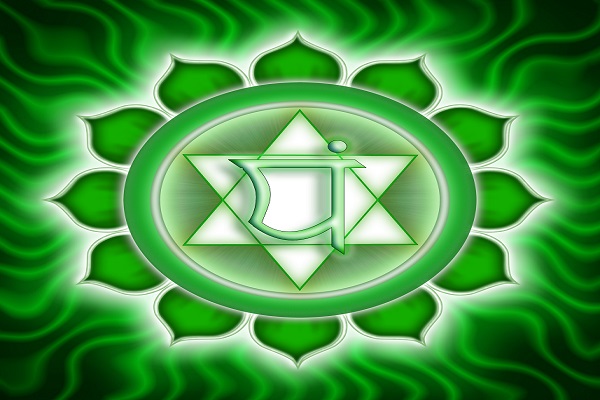Om Mani Padme Hum ॐ मणिपद्मे हूँ The mantra of Avalokiteshvara, represents the entirety of the Buddhist teachings condensed into a 6-syllable mantra. Roughly translated: Om – The primordial sound (is) Mani – a jewel, or a little bead, (it’s) Padme – a lotus flower; (Hum) the spirit of enlightenment. (There are other semantic transliterations of the Sanskrit.)

Avalokiteshvara, beloved bodhisattva of Mahayana (Greater Vehicle), Theravada (Way of the Elders), and Vajrayana (Diamond Vehicle), or the Tantric branch of Buddhism is associated with the heart, and the heart chakra (Anahata), and symbolizes the virtue of compassion, exemplifying the bodhisattva’s resolve to postpone his own Buddhahood until he has helped every sentient being on earth achieve liberation (moksha; literally, “release”) from suffering (dukkha) and the process of death and rebirth (samsara).
The Anahata Chakra, containing two triangles, one pointing up, the other down, symbolizes the confluence of the upper and lower chakras in the void known according to Shaivite Tantric esoteric teachings as the Knot of Vishnu. When the knot is untied and the universal energies are free to flow through the central channel, sushumna nadi, the fears and feelings of separateness and restlessness previously associated with the lower self-identification in the Knot of Brahma, located at Muladhara chakra around the perineum, have been overcome, transcended and sublimated. One is enabled to act for the good of humanity, to serve with faith, love and compassion.
Over-attachment to the desire to act for the betterment of others, attachment to the good, and a reliance on one’s own ways as best, is one of the paradoxical tell-tale signs of a heart still tied up in this knot. Untying this knot means the practitioner should now try to understand acts minus the sense of doership; less my will, more Thy will so to speak.
Regarding the indications and contraindications in the Vishnu Granthi, or knot of consciousness in the heart center, I’d like to share this brief passage from the Vijnana Bhairava Tantra. Verse 64 talks about achieving the equilibrium not yet established in the heart, via the merging of two pranic winds, prana and apana, the upward and downward moving airs.
The several scholarly translations presented here, when studied together, offer not only an excellent perspective for mindful adjustments to one’s meditation and pranayama exercises, but a thought-provoking consideration on the value of classical translations themselves even from the most unimpeachable academic sources. The stark differences in the translation details, as well as the clarity offered by each, should also further embolden the practitioner with the confidence to rely on their own intuition in such matters when duly supported by good knowledge.
vāyu-dvayasya saṃghaṭṭād antar vā bahir antataḥ |
Vijnana Bhairava Tantra Verse 64
yogī samatva-vijñāna- samudgamana-bhājanam || 64 ||
- “Due to the dynamic tension (or fusion, sanghaṭṭa) of the two prāṇa-vāyus at the external or internal terminus, the yogī becomes a ‘worthy vessel’ for the arising of equality consciousness.” (WALLIS)
- “By the fusion of the two breaths, prāṇa (exhalation) arising inwardly in the centre and apāna (inhalation) arising externally in dvādaśānta, there arises finally a condition in which there is complete cessation of both whether in the centre or in the dvādaśānta. By meditating over that condition of void in which there is no feeling of either prāṇa or apāna, the yogi becomes so competent that there arises in him the intuitive experience of Equality.” (SINGH)
- “By the coming together of the two breaths, either within (the heart) or outside (in the End of the Twelve), finally (when they come to a halt), the yogī (experiences the reality which) is the vessel of the emergence of the knowledge of the equality (of all things).” (DYCZKOWSKI)
- “By the meeting of the two breaths, at the extreme point, either within or outside (the body), the yogi becomes capable of experiencing the rise of the knowledge of equality.” (BÄUMER)
- “From the fusion of both vāyus (prāṇa and apāna) inside or outside (the body), the yogi attains equilibrium and becomes fit for the proper manifestation of consciousness.” (SATSANGI)
- “In any activity, concentrate on the gap between the inbreath and the outbreath. Thus attain to bliss.” (ODIER)
- “With utmost devotion, center on the two junctions of breath and know the knower.” (REPS)

During my time in the Himalaya, apprenticed to the Wisdom King, Babaji Swamy Vinayagananda, I often stayed in the Tibetan Quarter of one of the local townships. Maharaj would come to town every morning and we’d meet on the curb for tea and to read the news under the sun until lunchtime when we’d take a light repast at a Tibetan eatery called Chopsticks. This mantra was always playing over the shop’s speakers; every year there was a different version. One of those years I decided to buy the cd. I offer it here for anyone reading in, with tons of love and blessings upon blessings.

…is a Saiva Tantrika, Gyana Yogi and founder of Uma Maheshwara Yoga & Ayurveda. David has an MA in Semiotics, lives in Japan with his family and works as a coach in L & D, devoting his time to developing science-based tools and programs that help people reach the fullest potential of the human condition.
Discover more from REAL YOGA
Subscribe to get the latest posts sent to your email.


